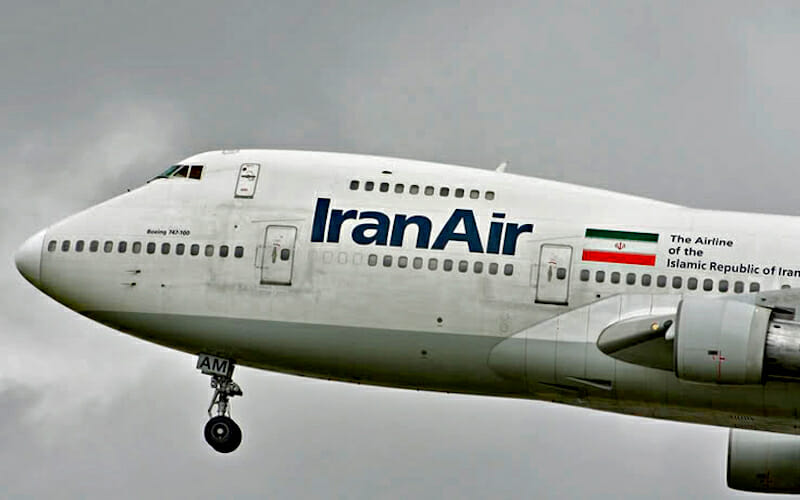
Does it Really Matter if Iranians Can’t Fly Safely?
Aside from its declining currency, which is known as one of the world’s most worthless currencies, Iran is reputed to have one of the most unsafe and aged aviation fleets. In recent years, hundreds of passengers have lost their lives while flying on Iranian airliners due to their age and the failure of the companies to improve their standards.
The inability of Iranian airlines to buy new aircraft and renovate their fleet is mostly a result of economic sanctions that the United States has imposed on Iran since the 1980s.
Some of the deadliest aviation accidents in the world have involved Iranian airliners. A notable example is the Caspian Airlines Flight 7908, which was a scheduled commercial flight from Tehran to the Armenian capital of Yerevan. The plane, a Tupolev Tu-154, crashed outside the city of Qazvin shortly after taking off on 15 July 2009, killing all 153 passengers and 15 crew on board. Another major incident happened in February 2018, when Iran Aseman Airlines Flight 3704 crashed into Mount Dena near the Noqol village in the Isfahan Province onboard from Tehran to the southwestern Iranian city of Yasuj, causing the death of all 6 crew and 60 passengers.
It was after this heartrending air crash that media teamed up to discuss the impact of US sanctions on Iran’s aviation industry and that years of sanctions had left Iran with one of the oldest fleets in the world. There were several other accidents of similar magnitude in recent years that claimed hundreds of innocent lives, and at the time grabbed national and international attention and prompted frantic responses by Iranian authorities. However, there has been no change of policies nor any improvement in the low standards of Iran’s aviation industry.
When the Joint Comprehensive Plan of Action, popularly known as the Iran deal, was agreed to between Iran and the six world powers, including the United States, avenues emerged for Iranian airlines to buy new aircraft for civilian use. It was one of the stipulations of the nuclear agreement that Iran would be allowed to buy new and modern commercial passenger aircraft from European and American manufacturers.
Article 22 of the Iran deal under “sanctions” notes, “the United States will, as specified in Annex II and in accordance with Annex V, allow for the sale of commercial passenger aircraft and related parts and services to Iran.” Article 5.1.1. of the Annex II says the United States will commit to “allow for the sale of commercial passenger aircraft and related parts and services to Iran by licensing the export, re-export, sale, lease or transfer to Iran of commercial passenger aircraft for exclusively civil aviation end-use and the export, re-export, sale, lease or transfer to Iran of spare parts and components for commercial passenger aircraft,” and other related services.
The inclusion of these crystal clear stipulations in the nuclear deal between Iran and the six world powers indicates the high importance Iran paid to improving its air fleet.
At the time the Iran deal was agreed to, the two major international aircraft manufacturers Airbus and Boeing entered into unprecedented, direct negotiations with Iran to sell their aircraft to the Persian Gulf nation. In December 2016, Airbus signed a contract to supply Iran Air, the flag carrier of Iran, with 100 aircraft worth $19 billion. Three aircraft have been delivered so far, the first imports in 20 years. Boeing had also made arrangements to provide 80 aircraft for $17 billion and 30 aircraft for Aseman Airlines worth $3 billion. The French-Italian aircraft manufacturer ATR had also pledged to provide 20 aircraft to Iran Air. However, the announcement by President Trump that the United States will not remain in the Iran deal means that these companies will have to cancel their agreements with Iran.
Aside from leaving Iranian airlines with no option but to continue operating aged and unsafe aircraft, there are ripple effects for the American and European employees as well. Company reports from Airbus, the European aircraft manufacturer, indicates that 5,000 of its employees have been affected by President Trump’s withdrawal from the Iran deal.
Figures and data from reliable sources such as the Aviation Safety Network indicate that there have been 28 civilian aircraft crashes in Iran since 2000 that claimed more than 500 lives. The average age of an aircraft operated by Iran Air is 26 years. With a population of 80 million, Iran Air has only 31 aircraft in service. Emirates, the largest airline in the Middle East based in the United Arab Emirates operates 103 aircraft that are on average seven years old. These figures are appalling and are a result of the sanctions.
Trump’s withdrawal from the Iran deal may not change many things, including Iran’s behavior. It will not necessarily lead to a collapse of the ruling establishment in Tehran as some pundits envision. However, it definitely makes living difficult for the average Iranian.
To those who propose sanctions and claim that they will not hurt the people but will only serve as a leverage on the leaders and politicians, the many lives that were lost in heartrending aviation accidents provides an example of how sanctions hurt the average person. Let’s be honest and respond to this question: does it really matter if the Iranian people can’t travel safely?

